View in other NatureServe Network Field Guides
NatureServe
Montana
Utah
Wyoming
Idaho
Wisconsin
British Columbia
South Carolina
Yukon
California
New York
Limestone Mnium Moss - Mnium thomsonii
General Description
Plants: Acrocarpous (FNA 2014), green with a touch of red, growing in open clumps of erect shoots. Stems unbranched (Crum and Anderson et al. 1981), mostly 10-20 mm tall, rarely to 70 mm (FNA 2014), possessing a central strand (Lawton 1971); macronemata mostly below (FNA 2014).
Leaves: Green or green with yellow tones, somewhat wavy, twisted or bent, and a little spiraled about the stem when dry, 1.5 -4.5 mm in length, the upper leaves much larger (FNA 2014) and more crowded than those below (Crum and Anderson et al. 1981), lance-shaped grading to elliptic, sometimes with ovate tendencies, ending in an acute leaf tip, or sometimes curved to more broadly-angled, sometimes developing an apiculus or cusp; base extending well-down the stem; margins flat, sometimes russet or more brownish, dentate in the distal half to sometimes a little below the middle, the teeth varying in size and sharpness, mostly in pairs; costa reaching the leaf tip, or sometimes a bit shy of or extending slightly beyond it, usually a little dentate on the distal part of the dorsal surface (FNA 2014), red-tinged (Crum and Anderson et al. 1981).
Leaf Cells: Margins of 2 cell-layers, bordered with long, narrow cells in 1-4 rows (FNA 2014); medial cells of the lamina about as wide as long or a little elongated, a bit larger toward the center than near the margins, mostly in up-and-down rows, seldom obliquely-rowed (FNA 2014).
Phenology
Fruit ripens in the summer (FNA 2014).
Diagnostic Characteristics
Teeth of the dorsal costa and those of the margins are often absent in little plants. Cells of the lamina are the smallest of any Mnium species (FNA 2014).
Range Comments
North American Range
AK to NU, BC to NL and NS (except SK and PE), WA to CA, AZ, MT to NM, ND to NE, MN, MO and AR, most states e and ne of MI, OH, and KY, also NC and FL (FNA 2014). Known in Montana from Carbon, Flathead, Glacier, Lake, Missoula, Powell, and Sanders Counties (Elliott and Pipp 2016).
Observations in Montana Natural Heritage Program Database
Number of Observations: 18
(Click on the following maps and charts to see full sized version)
Map Help and Descriptions
Relative Density
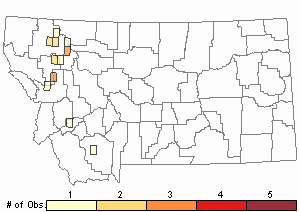
Recency
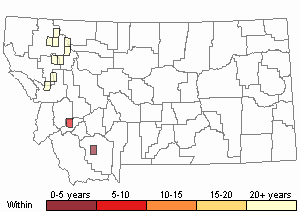
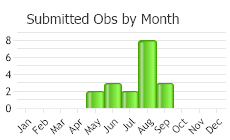
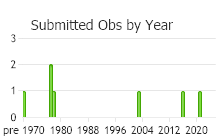
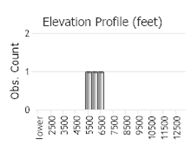 (Observations spanning multiple months or years are excluded from time charts)
(Observations spanning multiple months or years are excluded from time charts)
Habitat
Protected, damp stones, soil, and bark, frequently near watercourses and often in calcareous areas (Crum and Anderson et al. 1981). Ranging from lowlands to high elevations (FNA 2014).
Reproductive Characteristics
Dioicous. Seta solitary (FNA 2014), 13-18 mm tall, and somewhat red. Capsule nearly level to drooping (Crum and Anderson et al. 1981), sometimes reaching 5 mm in length, ochre to more brownish (FNA 2014), stomata sunken in the short neck (Crum and Anderson et al. 1981); exostome green with yellow tones (FNA 2014), thickly covered with tiny papillae; endostome segments with openings and paired cilia (Crum and Anderson et al. 1981). Calyptra draping like a hood (Lawton 1971).
Stewardship Responsibility
References
- Literature Cited AboveLegend:
 View Online Publication
View Online Publication Crum, H.A. and L.E. Anderson. 1981. Mosses of Eastern North America. 2 volumes. Columbia University Press, New York. 1328 pp.
Crum, H.A. and L.E. Anderson. 1981. Mosses of Eastern North America. 2 volumes. Columbia University Press, New York. 1328 pp. Elliott, J.C. and A.K. Pipp. 2018. A Checklist of Montana Mosses (1880-2018). Updated 3 January, 2020. Montana Natural Heritage Program, Helena, Montana. 73 pp.
Elliott, J.C. and A.K. Pipp. 2018. A Checklist of Montana Mosses (1880-2018). Updated 3 January, 2020. Montana Natural Heritage Program, Helena, Montana. 73 pp. Flora of North America Editorial Committee, eds. 2014. Flora of North America North of Mexico. Volume 28. Bryophytes: Mosses, Part 2. Oxford University Press, Inc., NY. xxi + 702 pp.
Flora of North America Editorial Committee, eds. 2014. Flora of North America North of Mexico. Volume 28. Bryophytes: Mosses, Part 2. Oxford University Press, Inc., NY. xxi + 702 pp. Lawton, E. 1971. Moss Flora of the Pacific Northwest. Hattori Botanical Laboratory. Japan: Yamabuki-cho, Shinjuku-ku, Tokyo. 362 pages plus appendices.
Lawton, E. 1971. Moss Flora of the Pacific Northwest. Hattori Botanical Laboratory. Japan: Yamabuki-cho, Shinjuku-ku, Tokyo. 362 pages plus appendices.
- Additional ReferencesLegend:
 View Online Publication
View Online Publication
Do you know of a citation we're missing? Elliot, J. C. 1993. Second checklist of Montana mosses. Unpublished report. U.S. Forest Service, Region 1. Missoula, MT. 45 pp.
Elliot, J. C. 1993. Second checklist of Montana mosses. Unpublished report. U.S. Forest Service, Region 1. Missoula, MT. 45 pp. Lawton, E. 1971. Keys for the Identification of the Mosses on the Pacific Northwest. Reprinted from 'Moss Flora of the Pacific Northwest'. Published as Supplement No. 2 of the Journal of the Hattori Botanical Laboratory. Nichinan, Miyazaki, Japan. 66 pp.
Lawton, E. 1971. Keys for the Identification of the Mosses on the Pacific Northwest. Reprinted from 'Moss Flora of the Pacific Northwest'. Published as Supplement No. 2 of the Journal of the Hattori Botanical Laboratory. Nichinan, Miyazaki, Japan. 66 pp. Malcolm, B., N. Malcolm, J. Shevock, and D. Norris. 2009. California Mosses. Nelson, New Zealand: Micro-Optics Press. 430 pp.
Malcolm, B., N. Malcolm, J. Shevock, and D. Norris. 2009. California Mosses. Nelson, New Zealand: Micro-Optics Press. 430 pp. Smith, A.J.E. 1980. The Moss Flora of Britain and Ireland. Cambridge University Press, Cambridge. 705 pp.
Smith, A.J.E. 1980. The Moss Flora of Britain and Ireland. Cambridge University Press, Cambridge. 705 pp. Vitt, D. J. Marsh, and R. Bovey. 1988. Mosses, Lichens & Ferns of Northwest North America. Seattle, WA: University of Washington Press. 296 p.
Vitt, D. J. Marsh, and R. Bovey. 1988. Mosses, Lichens & Ferns of Northwest North America. Seattle, WA: University of Washington Press. 296 p.
- Web Search Engines for Articles on "Limestone Mnium Moss"





